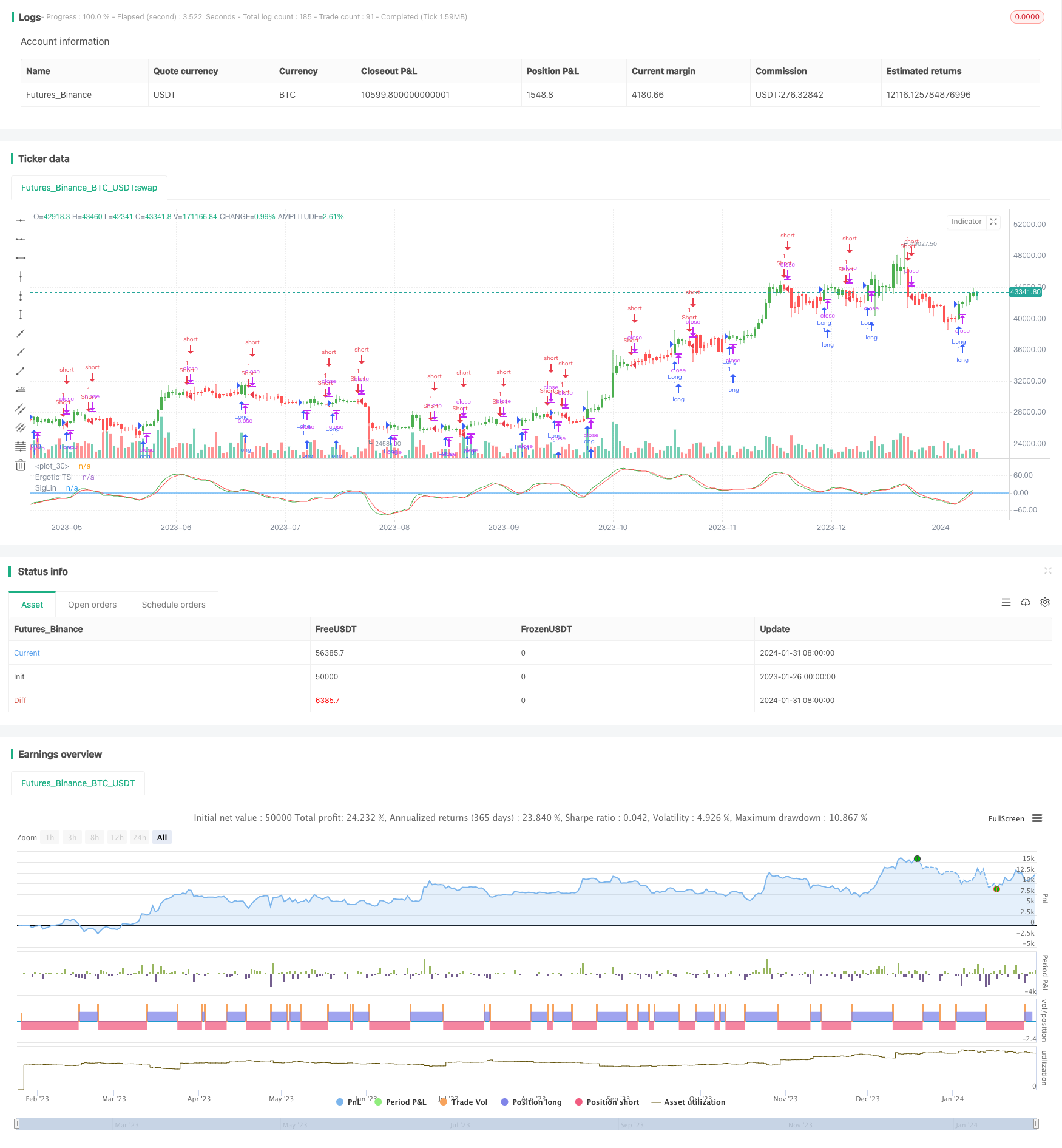Strategi perdagangan konvergensi arah momentum ergotik
Penulis:ChaoZhang, Tanggal: 2024-02-02 10:51:11Tag:

Gambaran umum
Nama strategi ini adalah Ergotic Momentum Direction Convergence Trading Strategy. Ini adalah strategi perdagangan kuantitatif yang dirancang berdasarkan indikator teknis yang dijelaskan dalam buku William Blau
Logika Strategi
Indikator inti dari strategi ini adalah TSI ergotik, dan rumus perhitungannya adalah sebagai berikut:
Val1 = 100 * EMA(EMA(EMA(price change, r), s), u)
Val2 = EMA(EMA(EMA(absolute value of price change, r), s), u))
Ergotic TSI = If Val2 != 0, Val1/Val2, else 0
di mana r, s, u adalah parameter perataan. Indikator ini mencerminkan rasio perubahan harga terhadap nilai absolut perubahan harga, yang termasuk dalam indikator osilator momentum. Kemudian kita menghitung rata-rata pergerakan EMA dari TSI Ergotic sebagai garis sinyal. Pergi panjang ketika TSI melintasi garis sinyal, dan pergi pendek ketika melintasi di bawahnya.
Analisis Keuntungan
Keuntungan utama dari strategi ini adalah:
- Kemampuan yang kuat untuk menangkap tren perubahan harga
- Menyaring fluktuasi harga dengan baik
- Karakteristik divergensi yang relatif baik
- Pengaturan parameter yang fleksibel untuk menyesuaikan kelancaran
Analisis Risiko
Ada juga beberapa risiko dalam strategi ini:
- Sinyal yang salah mungkin terjadi pada titik pembalikan tren
- Pengaturan parameter yang tidak tepat dapat kehilangan peluang perdagangan atau meningkatkan sinyal palsu
- Parameter perlu disesuaikan dengan produk dan lingkungan perdagangan yang berbeda Risiko dapat dikendalikan dengan mengoptimalkan parameter, menggabungkan indikator lain untuk konfirmasi, dan mengatur stop loss.
Arahan Optimasi
Strategi ini dapat dioptimalkan dalam aspek berikut:
- Uji input harga yang berbeda, seperti harga buka, tutup, pertengahan, dll.
- Sesuaikan nilai parameter r, s, u untuk menemukan kombinasi parameter optimal
- Tambahkan indikator atau filter lain untuk mengkonfirmasi sinyal lebih lanjut
- Tetapkan titik stop loss dan mekanisme exit
Kesimpulan
Strategi ini mengintegrasikan pertimbangan perubahan momentum, penilaian tren dan fitur divergensi. Ini dapat secara efektif menangkap peluang tren. Dengan optimasi parameter, penyaringan sinyal dan metode pengendalian risiko, kinerja strategi yang baik dapat dicapai. Secara keseluruhan, strategi dirancang dengan wajar dan layak penelitian dan praktik lebih lanjut.
/*backtest
start: 2023-01-26 00:00:00
end: 2024-02-01 00:00:00
period: 1d
basePeriod: 1h
exchanges: [{"eid":"Futures_Binance","currency":"BTC_USDT"}]
*/
//@version = 2
////////////////////////////////////////////////////////////
// Copyright by HPotter v1.0 13/12/2016
// r - Length of first EMA smoothing of 1 day momentum 4
// s - Length of second EMA smoothing of 1 day smoothing 8
// u- Length of third EMA smoothing of 1 day momentum 6
// Length of EMA signal line 3
// Source of Ergotic TSI Close
//
// This is one of the techniques described by William Blau in his book "Momentum,
// Direction and Divergence" (1995). If you like to learn more, we advise you to
// read this book. His book focuses on three key aspects of trading: momentum,
// direction and divergence. Blau, who was an electrical engineer before becoming
// a trader, thoroughly examines the relationship between price and momentum in
// step-by-step examples. From this grounding, he then looks at the deficiencies
// in other oscillators and introduces some innovative techniques, including a
// fresh twist on Stochastics. On directional issues, he analyzes the intricacies
// of ADX and offers a unique approach to help define trending and non-trending periods.
//
// You can use in the xPrice any series: Open, High, Low, Close, HL2, HLC3, OHLC4 and ect...
// You can change long to short in the Input Settings
// Please, use it only for learning or paper trading. Do not for real trading.
////////////////////////////////////////////////////////////
strategy(title="Ergotic TSI Strategy Backtest")
r = input(4, minval=1)
s = input(8, minval=1)
u = input(6, minval=1)
SmthLen = input(3, minval=1)
reverse = input(false, title="Trade reverse")
hline(0, color=blue, linestyle=line)
xPrice = close
xPrice1 = xPrice - xPrice[1]
xPrice2 = abs(xPrice - xPrice[1])
xSMA_R = ema(ema(ema(xPrice1,r), s),u)
xSMA_aR = ema(ema(ema(xPrice2, r), s),u)
Val1 = 100 * xSMA_R
Val2 = xSMA_aR
xTSI = iff (Val2 != 0, Val1 / Val2, 0)
xEMA_TSI = ema(xTSI, SmthLen)
pos = iff(xTSI > xEMA_TSI, 1,
iff(xTSI < xEMA_TSI, -1, nz(pos[1], 0)))
possig = iff(reverse and pos == 1, -1,
iff(reverse and pos == -1, 1, pos))
if (possig == 1)
strategy.entry("Long", strategy.long)
if (possig == -1)
strategy.entry("Short", strategy.short)
barcolor(possig == -1 ? red: possig == 1 ? green : blue )
plot(xTSI, color=green, title="Ergotic TSI")
plot(xEMA_TSI, color=red, title="SigLin")
- Strategi lintas SMMA dan SMA yang dinamis
- Tren Mengikuti Strategi Berdasarkan Bollinger Bands, RSI dan Moving Average
- Strategi Trading Tren Berdasarkan Indikator MACD
- Strategi Stochastic & Moving Average dengan Filter Ganda
- Tren Berbasis Stoch RSI Mengikuti Strategi
- Strategi Penembusan Rata-rata Gerak Titik Tunggal
- Strategi Crossover Rata-rata Bergerak
- Strategi SuperTrend
- Strategi Stop Loss Moving Periode Parabolik dan Bollinger Band
- Strategi perdagangan berdasarkan moving average price
- Strategi Perdagangan Rata-rata Bergerak dan Stochastic
- Optimalisasi Tren Rata-rata Bergerak Ganda Mengikuti Strategi Berdasarkan Kombinasi Indikator
- Strategi Perdagangan Kuantum Efisien Menggabungkan
- Dual Moving Average Crossover dan Williams Indicator Combo Strategy
- Momentum Terobosan Strategi Silver Line
- RWI Volatility Contrarian Strategi
- Parabolik SAR Trend Tracking Stop Loss Reversal Strategi
- Strategi Crossover Indikator Momentum
- Strategi Stop Profit dan Stop Loss Dual Efisien Oscillation Breakthrough
- Strategi Penembusan Saluran Dua